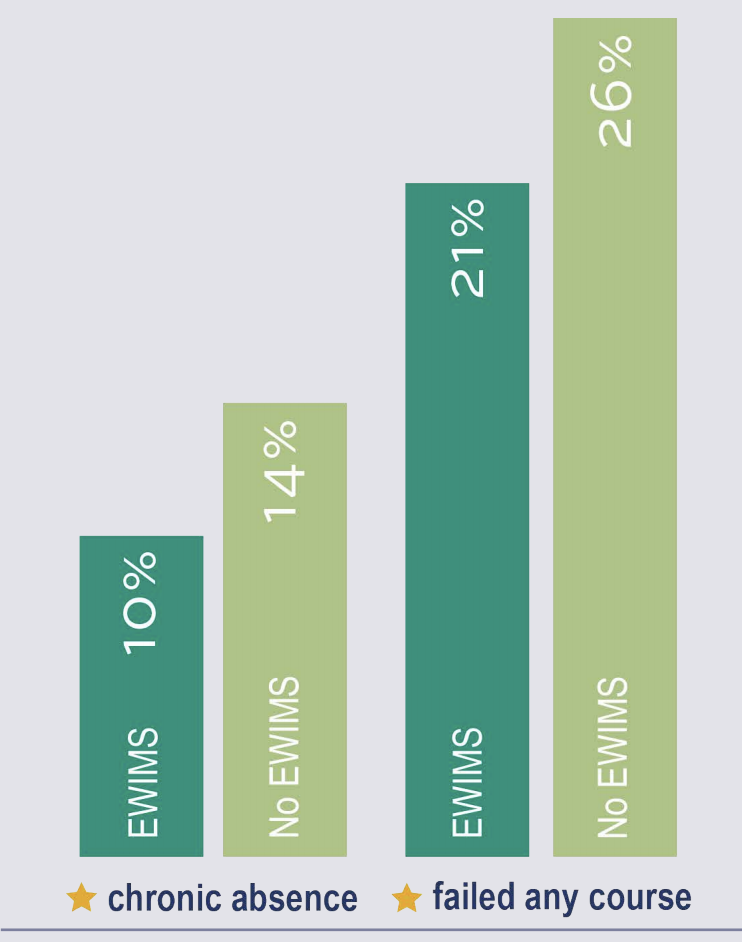
Early Warning Intervention and Monitoring System
Developed by the National High School Center at AIR, the Early Warning Intervention and Monitoring System, or EWIMS for short, provides schools with a comprehensive, systematic and effective approach to use data to identify students who are falling off track, provide supports or interventions tailored to students’ needs, monitor progress, and modify intervention strategies for students as needed. At the heart of EWIMS is a 7-step implementation process, supported by use of a data tool and two years of professional development to build the capacity of districts and schools.
EWIMS 7-Step Implementation Process
Two Years of Professional Development
Predictive Analytics Data Tool
7-Step Implementation Process
After receiving training, each school-based EWIMS team meets at least monthly to implement the 7-step continuous improvement process. The 7-step process guides educators to efficiently and systematically use data to identify students who show warning signs of falling off track early in high school and to monitor students’ progress.
The seven steps for implementation are:
Step 1—Establish roles and responsibilities. Schools establish a team to lead and carry out the EWIMS process, determine the frequency and duration of meetings, and develop a shared vision for the team’s work.
Step 2—Use the early warning system tool. The EWIMS team uses the tool to update lists of available interventions and strategies to support students and run automated or customized reports.
Step 3—Review the early warning system data. The EWIMS team focuses their attention on student- and school-level data, using a combination of research-based and locally validated indicators available in the tool. This data review process is intended to identify areas of focus and further investigation and this step is revisited any time new data become available.
Step 4—Interpret the early warning system data. The EWIMS team seeks out additional data (besides the indicators) to better understand the needs of individual students or groups of students. This step focuses on the underlying causes that might lead students to be identified as at risk on one or more indicators, using additional formal data (administrative records) and informal input (from teachers, family, and students).
Step 5—Assign and provide interventions. The EWIMS team members make decisions about assigning individual students to specific interventions in the school, district, and community. The EWIMS model does not prescribe specific interventions for schools to implement. Rather, the model provides schools flexibility to decide which interventions are best suited to their students’ needs.
Step 6—Monitor student progress. The EWIMS team examines the student risk indicators on an ongoing basis to monitor the progress of students who have already been assigned to interventions. If students continue to be identified as off track, the team may consider assigning them to different interventions; if some students are no longer at risk, the team may consider ramping down services. Over time, schools may refine their catalog of interventions based on their effectiveness, adding new interventions and dropping those that do not help students get back on track.
Step 7—Evaluate and refine the EWIMS process. Through active and structured reflection, EWIMS team members revise specific strategies or their general approach as needed and determine how best to allocate resources to support at-risk students. This step encourages EWIMS teams to make course corrections to any aspect of implementation.
Graduation Ready provides two years of professional development at no cost, including paid summer training and two years of coaching on the EWIMS 7-step process, as well as training on the data tool.
Harness the power of predictive analytics.
All districts will receive access to the BrightBytes Early Insights Suite, which interfaces directly with a wide range of student information systems. Using a combination of research-based and locally validated indicators for each district, the tool provides EWIMS teams from each school with intuitive and actionable reports that identify students at risk of not graduating on time based on attendance, course performance and behavior. In addition, teams will be able to assign students to interventions and monitor their progress within the tool.
EWIMS Works for Students and Schools.
A recent rigorous study of 73 high schools in three Midwestern states found that after only one year of implementation, EWIMS schools experience significant reductions in chronic absenteeism and course failure among students in Grades 9 and 10—two key predictors of on-time graduation.
.

EWIMS is an Evidence-Based Practice.
The Every Student Succeeds Act, 2015 (ESSA) requires that states identify high schools with graduation rates lower than 67 percent as low performing and use evidence-based practices to support these schools. EWIMS is an evidence-based practice that districts and schools can use to improve high school graduation outcomes.







